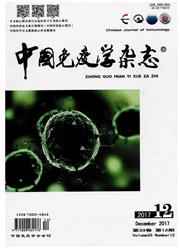

 中文摘要:
中文摘要:
目的:探讨槐定碱对内毒素血症小鼠肺组织LPS识别受体LBP、CD14、TLR4及下游炎症介质TNF-α的影响及意义。方法:BALB/c小鼠尾静脉注射LPS制备内毒素血症小鼠模型,注射LPS后30分钟给予槐定碱高(12 mg/kg)、中(6mg/kg)、低(3 mg/kg)三个剂量干预,并分别在2、6、12、24小时各时间点取血液和肺组织,肉眼及光镜观察肺组织的病理变化;以肺湿/干重(W/D)比检测肺水含量;用RT-PCR检测肺组织中LBP、CD14、TLR4的mRNA表达;Western blot检测肺组织TLR4蛋白的表达;放免法检测血清TNF-α含量。结果:与内毒素血症模型组小鼠肺组织比较,槐定碱三个剂量干预组均不同程度减轻内毒素血症小鼠肺组织病理损伤,降低肺组织W/D值,并且显著下调同时间点模型小鼠肺组织LBP、CD14、TLR4的mRNA表达及TLR4蛋白的表达;槐定碱高、中剂量干预可显著抑制模型小鼠血清TNF-α水平(P〈0.01或P〈0.05)。结论:槐定碱对内毒素血症小鼠肺组织的保护作用机制可能与下调LPS识别受体LBP、CD14、TLR4表达,抑制下游炎症因子TNF-α的释放有关。
 英文摘要:
英文摘要:
Objective:To investigate the effect and the possible mechanism of Sophoridine on pattern-recognition receptors of lipopolysaccharide(LPS) in Mouse with Endotoxemia.Methods:The lung injury mouse models were induced by vena caudalis injection of LPS(7 mg/kg,E.coli O55:B5) to BALB/c mouse.The Sophoridine(12 mg/kg,6 mg/kg,3 mg/kg)was injected via peritoneal cavity respectively,and at 2,6,12,24 hour after injection and the samples of blood and lung were obtained respectively.Pathological changes of lung tissues were observed,content of lung water were measured by wet to dry weight ratio.The mRNA expression of LBP,CD14 and TLR4 of lung tissue were measured by RT-PCR.Protein expression of TLR4 of lung tissue was observed by Western blot.Semun TNF-α level was measured by radioimmunoassay.Results:The result of Sophoridine intervention groups at each time-control-point all showed Sophoridine could significantly abate pathological histological change of lung tissue of LPS-induced lung injury model mice,and the lung wet/dry weight significantly went down.Compared with LPS model group,mRNA expression of LBP,CD14 and TLR4,and protein expression of TLR4 of the lung was significantly reduced in the Sophoridine 3 dose intervention groups.The levels of serum TNF-α in high and middle-dose groups were significantly lower than that of in low-dose group(P0.01 or P0.05).Conclusion:The mechanism of Sophoridine anti-endotoxin lung injury have strong relationship with down-regulating the expression of pattern recognition receptors LBP,CD14 and TLR4,and inhibiting the release of downstream inflammatory factor TNF-α.
 同期刊论文项目
同期刊论文项目
 同项目期刊论文
同项目期刊论文
 期刊信息
期刊信息
